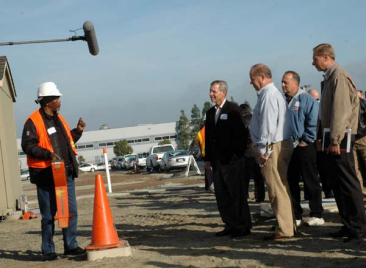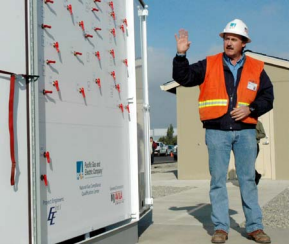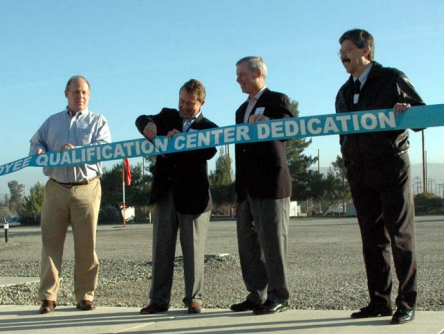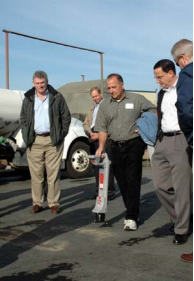Pacific Gas & Electric formally dedicated its new gas maintenance operations training facility in Livermore on Dec. 3, assuring that its IBEW-represented gas employees will continue to be among the best-trained in the country.
The dedication was an opportunity for both management and the union to acknowledge the critical link between training and safety, and to reaffirm their commitment to both.
“There is no ‘us and them’ on issue of safety and training,” said Local 1245 Business Manager Tom Dalzell, speaking at the dedication ceremony. “On every issue there is some overlap between company and union interests. On the issue of training there is unanimity of purpose.”
Bob Howard, PG&E Vice President for Gas Transmission and Distribution, called the facility “state of the art” and said it would be “the foundation for training for our gas system.”
The facility provides realistic scenarios for trainees to confront and deal with typical issues that gas workers encounter in the field. Among these are mark and locate, cathodic protection, and subsurface grading. Following the opening ceremony, demonstrations were conducted in each of these three areas.

Ron White demonstrates “Mark and Locate” procedures to PG&E Chief Operating Officer Jack Kennan, IBEW Business Manager Tom Dalzell, Gas Crew Foreman Mike Scafani, and PG&E Director of Labor Relations Steve Rayburn.
Conducting the Mark & Locate demonstration was Ron White, a Fieldman and 34-year IBEW member. Proper marking and locating of all PG&E equipment is essential to avoiding “digins”—excavation that inadvertently encounters and damages underground structures.
“We’re exposed out there if we don’t find our infrastructure properly,” said White, who demonstrated the use of the “Metro Tech” locator. “You always work with a map but you never assume the map reflects everything as is.”
In the Cathodic Protection demonstration, Kevin Amato explained how an electric current induced into the ground protects gas pipes against corrosion. However, sometimes another utility’s infrastructure—such as a water service—can become part of the circuit by accident. These unintended contacts cause a reduction of current in the circuit, which reduces the protective value of the current for preventing corrosion in gas lines.
“We’re looking for whatever is taking our current,” explained Amato as he took pipe and soil readings.
Luis Faria, a Senior Instructor at San Ramon, showed off the master panel that controls gas flow to various training center locations, enabling staff to create leaks for training purposes. Faria demonstrated the use of the Combustible Gas Indicator in detecting and grading leaks.
“You find the highest concentration, then probe out north, south, east and west every five feet until you zero out so you can grade
the leak,” he explained. Repairs are scheduled based on a leak grading system that determines the severity of the problem.

Senior Instructor Luis Faria shows off panel controlling gas flows to various training center locations.
PG&E Chief Operating Officer Jack Keenan, speaking at the opening ceremony, said that the focus on training and safety “is the right thing to do.”
“You need to have a process and train people in the process if you want safe results,” he said.
PG&E plans to add more facilities for electric training, including three 110-foot towers and an underground vault for transmission training.

Doing the honors at the ribbon-cutting ceremony are, from left: IBEW Local 1245 Business Manager Tom Dalzell, PG&E Vice President Bob Howard, PG&E Chief Operating Officer Jack Kennan, and PG&E Sr. Vice President Engineering and Operations.
